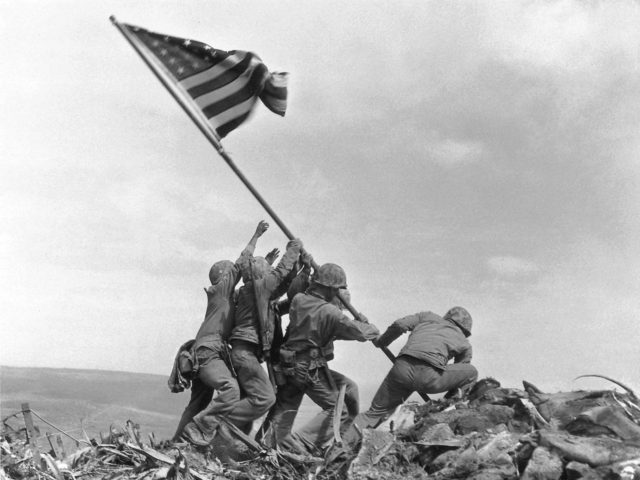Given that it is one of the most iconic images of American history, the depth of the controversy surrounding the flag-raising at Iwo Jima is surprising. The exact identity of the men in the photo remains the subject of much debate.
The mystery surrounding the raising the flag deepened on Tuesday, when the author of an enormously popular book on the subject announced he is no longer certain his father is one of the men in the picture.
James Bradley, author of Flags of Our Fathers — which became a movie in 2006, directed by Clint Eastwood — made his statement right after the Marine Corps announced it was opening a formal investigation into whether two of the men have been misidentified for the past 70 years.
The situation is confusing enough that the Associated Press had to correct its original story about the confusion over its own iconic photograph. The corrected version explains:
The Marines announced its inquiry more than a year after Eric Krelle, of Omaha, Nebraska, and Stephen Foley, of Wexford, Ireland, began raising doubts about the identity of one man. In November 2014, the Omaha World-Herald published an extensive story about their claims and Saturday was the first to report the Marines were looking into the matter.
Associated Press photographer Joe Rosenthal shot the photo on Feb. 23, 1945, on Mount Suribachi, amid an intense battle with the Japanese. Rosenthal didn’t get the names of the men, but the photo immediately was celebrated in the U.S. and President Franklin Roosevelt told the military to identify the men.
After some confusion, the Marines identified the men as John Bradley, Rene Gagnon, Ira Hayes, Harlon Block, Michael Strank and Franklin Sousley. All were Marines except Bradley, who was a Navy corpsman.
Block, Strank and Sousley were killed in fighting at Iwo Jima before the photo was distributed in the U.S.
Certainly the fog of war, the limitations of the era’s communications technology and record-keeping methods, and the deaths of three of the participants contributed to the difficulty of positively identifying the flag-raisers. Also, more than one flag was raised on Iwo Jima that day.
What is truly amazing is that seven decades elapsed before Stephen Foley, with “lots of time on his hands” following an operation, scrutinized some very minute details of the photo and challenged the accepted identification of Franklin Sousley as one of the men. They believe that man was really Private First Class Harold Henry Schultz, who survived World War II but died in 1995.
They do believe Sousley is in the photo, but he is the man previously identified as John Bradley — father of the man who wrote Flags of Our Fathers. That would mean Bradley does not appear in the photo at all, although his son maintains that he did participate in raising a flag on Iwo Jima that day and worked with the sculptors who created the Marine Corps War Memorial in Arlington, Virginia, which is based upon the famed photo.
With the aid of Eric Krelle, who runs a website dedicated to the Marines’ 5th Division, Foley pointed out such tiny but important details as the cuff on the misidentified man’s pants, the bill of his cap, and the equipment he carried, to make the case these details were inconsistent with other photos taken of Bradley on the same day.
John Bradley’s initial reaction was incredulity. “This is unbelievable,” he said, adding that he was “interested in facts and truths.”
A New York Times article from Tuesday clarifies that Bradley found the official Marine investigation unbelievable, but he has been aware of Foley and Krelle’s evidence since it was originally published in 2014. His analysis of their claims was delayed by illness and by the work he was doing on a new book about Vietnam.
“It wasn’t top of mind. It wasn’t a priority,” said Bradley. “I was overseas, and this past fall I was recovering from a disease I got in New Guinea that almost killed me. Now there’s interest in this, and I’m talking about it. I didn’t have the energy to carry the water all by myself.”
Bradley noted that the Marine Corps has, until now, “firmly” stood behind the established identification of the men in the photo, and it was consistent with the research Bradley conducted for Flags of Our Fathers.
According to the New York Times account, it apparently required the involvement of historian Dustin Spence and the Smithsonian Channel to convince the Marines to open their inquiry.
“Our history is important to us, and even today, this iconic image still represents the fighting spirit of Marines and is a symbol of the tremendous accomplishments of our corps,” the Marines said in a statement. “As such, with the information and research provided by the Smithsonian Channel, who used advanced digital technology to examine battle footage, the Marine Corps decided to review their photo enhancements, film analysis and findings.”
The Marines said the Iwo Jima photo is “representative of the more than 70,000 U.S. Marines, sailors, soldiers and Coast Guardsmen that contributed to the battle,” and few would dispute that essential truth. We are one step closer to definitively establishing who was in the picture, but there should never be a moment’s doubt about who it honors.

COMMENTS
Please let us know if you're having issues with commenting.